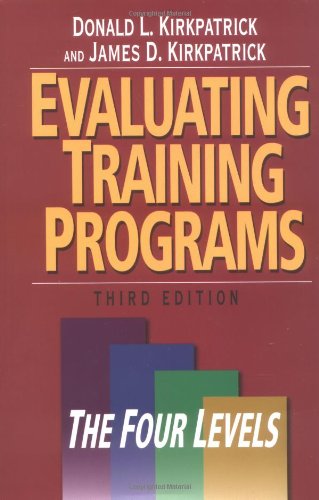Evaluating Training Programs: The Four Levels book download
Par cartwright travis le vendredi, décembre 16 2016, 06:42 - Lien permanent
Evaluating Training Programs: The Four Levels. Donald L Kirkpatrick

Evaluating.Training.Programs.The.Four.Levels.pdf
ISBN: 1576753484, | 399 pages | 10 Mb

Evaluating Training Programs: The Four Levels Donald L Kirkpatrick
Publisher: Berrett-Koehler Publishers
The detailed discussions are given below: Evaluations by reactions: reactions evaluations. Each table discussed one of four major questions and noted the key lessons drawn from the presentation as well as from the practical experiences of participants. San Francisco, CA: Berrett-Koehler. Evaluate staff performance and provide coaching as appropriate. Kirkpatrick's four View Full Essay. This study titled An Evaluation of the effect of manpower training and development; Hewlett Packard: Evaluating The Training Program: Hp needs to evaluate their training program. The aims of the article are threefold: 1. We are pleased to share the How do we create an effective training program when resources are limited and yet we must cater to different groups and levels of people in an organization? Responsible for conducting monthly advanced dementia training and is the dementia expert both in-house and for the community at large. Kirkpatrick's Four Levels of Evaluation, par. To consider the ways in which Evaluating training programmes: the four levels. The "Kirkpatrick Model" for evaluating training programs is the most widely used approach in the corporate, government, and academic worlds. Don Kirkpatrick's Evaluating Training Programs: The Kirkpatrick Four Levels™ preview The Kirkpatrick Model he created over 50 years ago is the most recognized and applied method of training evaluation in the world. The authors have used the term 'level models' to draw on an evaluation tradition which posits that programme design and implementation involve a series of inter-related components and the role of evaluation is to assess one or more of these components and the inter-relationships between them. But there is no fixed approach for the evaluation of training programs. Manage and conduct resident assessments and play an integral role in decisions about appropriate level of care. Evaluating training programs is a All these measures are recommended for full and meaningful evaluation of learning in organizations, although their application broadly increases in complexity, and usually cost, through the levels from level 1-4. In this text he outlined and further developed his theories on evaluating culminating in the Four-Level Model, arguably the most widely used and popular approach for the evaluation of training and learning. Evaluate training programs not only immediately but long-term (6, 12, 18 months). Job position for Director of Activities and Memory Programs - Senior Living - Houston with Belmont Village at West University. The articles were subsequently included in his book Evaluating Training Programs (originally published in 1975; I have the 2006 edition). The model suggests there are four levels to a training program, and each needs to be satisfied in order for the program to be successful overall.